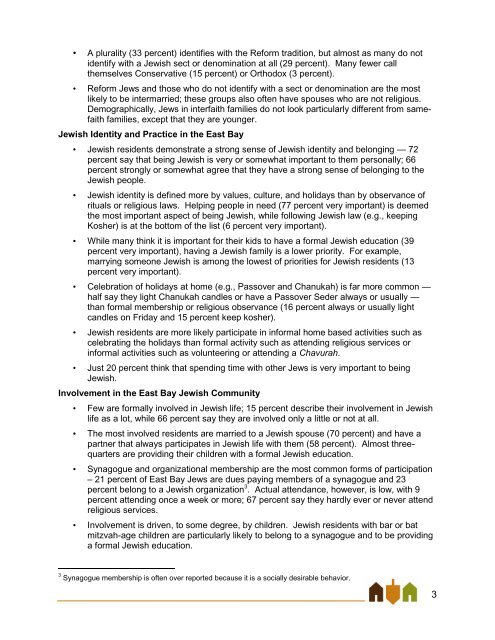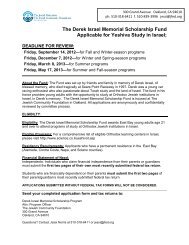East Bay Jewish Community Study - Jewish Federation of the ...
East Bay Jewish Community Study - Jewish Federation of the ...
East Bay Jewish Community Study - Jewish Federation of the ...
Create successful ePaper yourself
Turn your PDF publications into a flip-book with our unique Google optimized e-Paper software.
• A plurality (33 percent) identifies with <strong>the</strong> Reform tradition, but almost as many do not<br />
identify with a <strong>Jewish</strong> sect or denomination at all (29 percent). Many fewer call<br />
<strong>the</strong>mselves Conservative (15 percent) or Orthodox (3 percent).<br />
• Reform Jews and those who do not identify with a sect or denomination are <strong>the</strong> most<br />
likely to be intermarried; <strong>the</strong>se groups also <strong>of</strong>ten have spouses who are not religious.<br />
Demographically, Jews in interfaith families do not look particularly different from samefaith<br />
families, except that <strong>the</strong>y are younger.<br />
<strong>Jewish</strong> Identity and Practice in <strong>the</strong> <strong>East</strong> <strong>Bay</strong><br />
• <strong>Jewish</strong> residents demonstrate a strong sense <strong>of</strong> <strong>Jewish</strong> identity and belonging — 72<br />
percent say that being <strong>Jewish</strong> is very or somewhat important to <strong>the</strong>m personally; 66<br />
percent strongly or somewhat agree that <strong>the</strong>y have a strong sense <strong>of</strong> belonging to <strong>the</strong><br />
<strong>Jewish</strong> people.<br />
• <strong>Jewish</strong> identity is defined more by values, culture, and holidays than by observance <strong>of</strong><br />
rituals or religious laws. Helping people in need (77 percent very important) is deemed<br />
<strong>the</strong> most important aspect <strong>of</strong> being <strong>Jewish</strong>, while following <strong>Jewish</strong> law (e.g., keeping<br />
Kosher) is at <strong>the</strong> bottom <strong>of</strong> <strong>the</strong> list (6 percent very important).<br />
• While many think it is important for <strong>the</strong>ir kids to have a formal <strong>Jewish</strong> education (39<br />
percent very important), having a <strong>Jewish</strong> family is a lower priority. For example,<br />
marrying someone <strong>Jewish</strong> is among <strong>the</strong> lowest <strong>of</strong> priorities for <strong>Jewish</strong> residents (13<br />
percent very important).<br />
• Celebration <strong>of</strong> holidays at home (e.g., Passover and Chanukah) is far more common —<br />
half say <strong>the</strong>y light Chanukah candles or have a Passover Seder always or usually —<br />
than formal membership or religious observance (16 percent always or usually light<br />
candles on Friday and 15 percent keep kosher).<br />
• <strong>Jewish</strong> residents are more likely participate in informal home based activities such as<br />
celebrating <strong>the</strong> holidays than formal activity such as attending religious services or<br />
informal activities such as volunteering or attending a Chavurah.<br />
• Just 20 percent think that spending time with o<strong>the</strong>r Jews is very important to being<br />
<strong>Jewish</strong>.<br />
Involvement in <strong>the</strong> <strong>East</strong> <strong>Bay</strong> <strong>Jewish</strong> <strong>Community</strong><br />
• Few are formally involved in <strong>Jewish</strong> life; 15 percent describe <strong>the</strong>ir involvement in <strong>Jewish</strong><br />
life as a lot, while 66 percent say <strong>the</strong>y are involved only a little or not at all.<br />
• The most involved residents are married to a <strong>Jewish</strong> spouse (70 percent) and have a<br />
partner that always participates in <strong>Jewish</strong> life with <strong>the</strong>m (58 percent). Almost threequarters<br />
are providing <strong>the</strong>ir children with a formal <strong>Jewish</strong> education.<br />
• Synagogue and organizational membership are <strong>the</strong> most common forms <strong>of</strong> participation<br />
– 21 percent <strong>of</strong> <strong>East</strong> <strong>Bay</strong> Jews are dues paying members <strong>of</strong> a synagogue and 23<br />
percent belong to a <strong>Jewish</strong> organization 3 . Actual attendance, however, is low, with 9<br />
percent attending once a week or more; 67 percent say <strong>the</strong>y hardly ever or never attend<br />
religious services.<br />
• Involvement is driven, to some degree, by children. <strong>Jewish</strong> residents with bar or bat<br />
mitzvah-age children are particularly likely to belong to a synagogue and to be providing<br />
a formal <strong>Jewish</strong> education.<br />
3 Synagogue membership is <strong>of</strong>ten over reported because it is a socially desirable behavior.<br />
3




